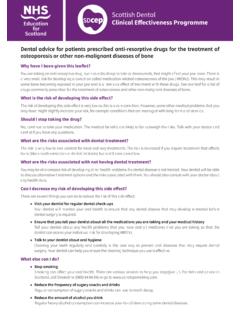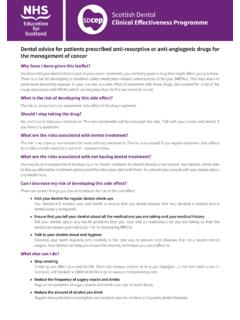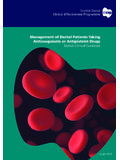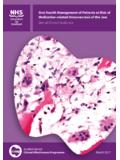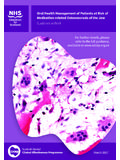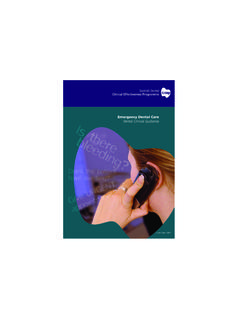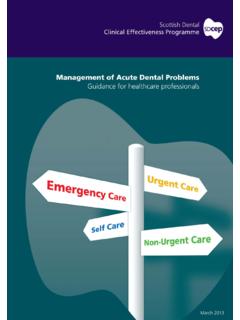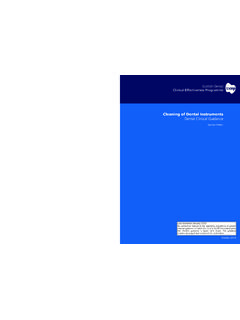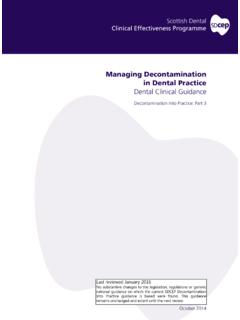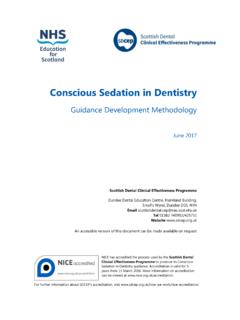Transcription of Oral Health Management of Patients at Risk of Medication ...
1 March 2017 Oral Health Management of Patients at Risk of Medication - related osteonecrosis of the JawGuidance in BriefFor further details, please refer to the full guidance, available at In the situation where a patient initially presents with an established history of anti - resorptive or anti -angiogenic drug use, follow the advice for extractions or other procedures which impact on bone in the lower of the Oral Health Management of Patients at Risk of MRONJ Scottish Dental Clinical Effectiveness Programme. SDCEP operates within NHS Education for Scotland. You may copy or reproduce the information in this document for use within NHSS cotland and for non-commercial educational purposes. Use of this document for commercial purposes is not permitted. ISBN 978 1 905829 29 3. First published Dental Clinical Effectiveness ProgrammeDundee Dental Education Centre, Frankland Building, Small s Wynd, Dundee DD1 4 HNEmail Tel 01382 740992/425751 Website | Designed and typeset by the NES Design Service | MARCH 2017 Carry out all routine dental treatment as normal and continue to provide personalised preventive advice in primary not prescribe antibiotic or antiseptic prophylaxis following extractions or other bone-impacting treatments specifically to reduce the risk of MRONJ.
2 Treat routinely for scale and polish, simple restorations, recall and radiological review. If an extraction or any oral surgery or procedure which may impact on bone is necessary, discuss the risk of the procedure with the patient (or carer, where appropriate) to ensure valid consent and follow the recommended Management strategy for each patient based on their allocated risk group. Advise the patient to contact the practice if they have any concerns, such as unexpected pain, tingling, numbness, altered sensation or swelling in the extraction area. Review healing. If the extraction socket is not healed at 8 weeks and you suspect that the patient has MRONJ, refer to an oral surgery/special care dentistry specialist as per local protocols. If you suspect a patient has spontaneous MRONJ, refer to an oral surgery/special care dentistry specialist as per local Management Perform straightforward extractions and procedures that may impact on bone in primary care.
3 Do not prescribe antibiotic or antiseptic prophylaxis unless required for other clinical reasons. Explore all possible alternatives to extraction where teeth could potentially be retained retaining roots in absence of infection. If extraction remains the most appropriate treatment, proceed as for low risk RiskHigher RiskMedically complex patientsConsider seeking advice from an oral surgery/special care dentistry specialist with regards to clinical assessment, treatment planning and ongoing Management . Discuss the risks of the procedure with the patient to ensure valid the patient as normal for extractions and any other procedure which impacts on bone. Do not prescribe antibiotic prophylaxis unless otherwise to avoid these procedures by considering other treatment extraction or other procedure which impacts on bone remains the most appropriate option, discuss the risks of the procedure with the patient to ensure valid healing If the extraction socket is not healed at 8 weeks and you suspect that the patient has MRONJ, refer to an oral surgery/special care dentistry specialist as per local any patient with evidence of spontaneous a subsequent or other procedure which impacts on bone is requiredLow risk patientsHigher risk patientsAssess the patient s level of MRONJ risk (See Table and Figure ).
4 Assign and record a risk the patient they are at risk of MRONJ. Emphasise that the risk is small and discuss what the patient can do to reduce their risk improve their oral hygiene, reduce sugary snacks and drinks, limit alcohol intake, stop smoking. Aim to get the patient as dentally fit as feasible, with extractions where required, and then treat routinely for scale and polish, simple restorations, recall and radiological review. At initial consultationNESD0691 Oral Health Quick Ref Guide A5 TRifold 106/03/2017 10:30 Assess whether a patient taking anti - resorptive or anti -angiogenic drugs is at low risk or higher risk of developing MRONJ based on their medical condition, type and duration of therapy and any other complicating factors and record this in the patient s clinical notes. Ask about past, current, or possible future use of anti - resorptive or anti -angiogenic drugs when taking or confirming a medical history.
5 Be aware that any low risk patient who continues to take bisphosphonate drugs after their five-year Medication review should be reclassified as higher AssessmentBefore commencement of anti - resorptive or anti -angiogenic drug therapy, or as soon as possible thereafter, aim to get the patient as dentally fit as feasible, prioritising preventive care. Higher risk cancer Patients should preferably undergo a thorough dental assessment, with remedial dental treatment where required, prior to commencement of the drug therapy. Advise the patient (or carer, where appropriate) that there is a risk of developing MRONJ but ensure they understand that the risk is small so that they are not discouraged from taking their Medication or undergoing dental treatment. Record that this advice has been given. Give personalised preventive advice to help the patient optimise their oral Health , emphasising the importance of: having a healthy diet and reducing sugary snacks and drinks; maintaining excellent oral hygiene; using fluoride toothpaste and fluoride mouthwash; stopping smoking; limiting alcohol intake; regular dental checks; reporting any symptoms such as exposed bone, loose teeth, non-healing sores or lesions, pus or discharge, tingling, numbness or altered sensations, pain or swelling as soon as possible.
6 Prioritise care that will reduce mucosal trauma or may help avoid future extractions or any oral surgery or procedure that may impact on bone: consider obtaining appropriate radiographs to identify possible areas of infection and pathology; undertake any remedial dental work; extract any teeth of poor prognosis without delay; focus on minimising periodontal/dental infection or disease; adjust or replace poorly fitting dentures to minimise future mucosal trauma; consider prescribing high fluoride toothpaste. For medically complex Patients for whom you would normally seek advice, including higher risk Patients who are being treated with anti - resorptive or anti -angiogenic drugs for the Management of cancer, consider consulting an oral surgery/special care dentistry specialist with regards to clinical assessment and treatment ManagementOral Health Management of Patients at Risk of Medication - related osteonecrosis of the Jaw is designed to assist and support primary care dental teams in providing appropriate care for Patients prescribed anti - resorptive or anti -angiogenic drugs.
7 The guidance aims to support the dental team to: assess a patient s individual Medication - related osteonecrosis of the jaw (MRONJ) risk level; optimise the patient s oral Health during the initial phase of drug treatment; continue to provide routine dental care for this patient group in the primary care main elements of Oral Health Management of Patients at Risk of Medication - related osteonecrosis of the Jaw are included in this Guidance in Brief. For a full appreciation of the recommendations and further advice on following them, refer to the full guidance. Management of these Patients is not difficult or onerous and, in most cases, can be carried out successfully in primary full guidance is available at *Correct at the time of publication. This list is not exhaustive. Be aware that drug trade names can change and new drugs may be released that may be implicated in MRONJ. Consult the SDCEP website ( ) for an up-to-date list of the drugs with an MHRA Drug Safety Update for risk of alendronic acid Binosto , Fosamax , Fosavance risedronate sodium Actonel , Actonel Combi zoledronic acid Aclasta , Zometa ibandronic acid Bondronat , Bonviva , Iasibon Quodixor pamidronate disodium Aredia sodium clodronate Bonefos , Clasteon ,Loron RANKL Inhibitor denosumab Prolia , Xgeva anti -angiogenic bevacizumab Avastin sunitinib Sutent aflibercept Zaltrap Drug TypeDrug NameTrade Name(s)Drugs Associated with MRONJ prescribed in the United Kingdom*IntroductionIs the patient currently taking a bisphosphonate drug or have they taken one in the past?
8 YESIs the patient currently taking denosumab or have they taken denosumab in the last nine months? NO RISKLOWRISKHIGHER RISK> 5 YEARS< 5 YEARSHow long have they taken/did they take the bisphosphonate drug for? YESNONONOYESNOYESNOYESHas the patient had a previous diagnosis of MRONJ? Is the patient being treated with anti - resorptive or anti -angiogenic drugs for the Management of cancer? Is the patient being concurrently treated with a systemic glucocorticoid? NESD0691 Oral Health Quick Ref Guide A5 TRifold 206/03/2017 10:30 Assess whether a patient taking anti - resorptive or anti -angiogenic drugs is at low risk or higher risk of developing MRONJ based on their medical condition, type and duration of therapy and any other complicating factors and record this in the patient s clinical notes. Ask about past, current, or possible future use of anti - resorptive or anti -angiogenic drugs when taking or confirming a medical history.
9 Be aware that any low risk patient who continues to take bisphosphonate drugs after their five-year Medication review should be reclassified as higher AssessmentBefore commencement of anti - resorptive or anti -angiogenic drug therapy, or as soon as possible thereafter, aim to get the patient as dentally fit as feasible, prioritising preventive care. Higher risk cancer Patients should preferably undergo a thorough dental assessment, with remedial dental treatment where required, prior to commencement of the drug therapy. Advise the patient (or carer, where appropriate) that there is a risk of developing MRONJ but ensure they understand that the risk is small so that they are not discouraged from taking their Medication or undergoing dental treatment. Record that this advice has been given. Give personalised preventive advice to help the patient optimise their oral Health , emphasising the importance of: having a healthy diet and reducing sugary snacks and drinks; maintaining excellent oral hygiene; using fluoride toothpaste and fluoride mouthwash; stopping smoking; limiting alcohol intake; regular dental checks; reporting any symptoms such as exposed bone, loose teeth, non-healing sores or lesions, pus or discharge, tingling, numbness or altered sensations, pain or swelling as soon as possible.
10 Prioritise care that will reduce mucosal trauma or may help avoid future extractions or any oral surgery or procedure that may impact on bone: consider obtaining appropriate radiographs to identify possible areas of infection and pathology; undertake any remedial dental work; extract any teeth of poor prognosis without delay; focus on minimising periodontal/dental infection or disease; adjust or replace poorly fitting dentures to minimise future mucosal trauma; consider prescribing high fluoride toothpaste. For medically complex Patients for whom you would normally seek advice, including higher risk Patients who are being treated with anti - resorptive or anti -angiogenic drugs for the Management of cancer, consider consulting an oral surgery/special care dentistry specialist with regards to clinical assessment and treatment ManagementOral Health Management of Patients at Risk of Medication - related osteonecrosis of the Jaw is designed to assist and support primary care dental teams in providing appropriate care for Patients prescribed anti - resorptive or anti -angiogenic drugs.
